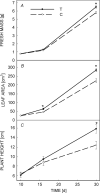Influence of additional far-red light on the photosynthetic and growth parameters of lettuce plants and the resistance of the photosynthetic apparatus to high irradiance
- PMID: 39651408
- PMCID: PMC11613827
- DOI: 10.32615/ps.2024.016
Influence of additional far-red light on the photosynthetic and growth parameters of lettuce plants and the resistance of the photosynthetic apparatus to high irradiance
Abstract
The effects of additional far-red light (FRL) on the photosynthetic and growth parameters of Lactuca sativa plants grown for 30 d and on the photosynthetic activity of the plants under high irradiance [4 h; 1,500 μmol(photon) m-2 s-1] were studied. The plants were grown under coloured light-emitting diodes at a ratio of red light (RL): blue light (BL): green light (GL): far-red light (FRL) = 0.7:1:0.3:0.4 or RL:BL:GL:FRL = 0.7:1:0.3:0.8 (test, T). Additional FRL led to an increase in plant biomass, height, and leaf area but to a decrease in photosynthesis and respiration rates. However, PSII activity was greater in plants with additional FRL. It is suggested that the increase in biomass occurred mainly due to an increase in leaf area but not in photosynthesis. In addition, PSII in the experiment was less resistant to high irradiance. The possible direct and indirect influences of the FRL on growth and photosynthesis were considered.
Keywords: Lactuca sativa; chlorophyll a fluorescence; far-red light; growth; photosynthesis; red light.
Copyright: © 2024 Shmarev et al.
Conflict of interest statement
The authors declare that they have no conflict of interest.
Figures




Similar articles
-
Extensive remodeling of the photosynthetic apparatus alters energy transfer among photosynthetic complexes when cyanobacteria acclimate to far-red light.Biochim Biophys Acta Bioenerg. 2020 Apr 1;1861(4):148064. doi: 10.1016/j.bbabio.2019.148064. Epub 2019 Aug 14. Biochim Biophys Acta Bioenerg. 2020. PMID: 31421078
-
Acclimation of Haslea ostrearia to light of different spectral qualities - confirmation of 'chromatic adaptation' in diatoms.J Photochem Photobiol B. 2004 Jul 19;75(1-2):1-11. doi: 10.1016/j.jphotobiol.2004.04.002. J Photochem Photobiol B. 2004. PMID: 15246344
-
Leaf Morphology, Photosynthetic Performance, Chlorophyll Fluorescence, Stomatal Development of Lettuce (Lactuca sativa L.) Exposed to Different Ratios of Red Light to Blue Light.Front Plant Sci. 2016 Mar 10;7:250. doi: 10.3389/fpls.2016.00250. eCollection 2016. Front Plant Sci. 2016. PMID: 27014285 Free PMC article.
-
Photoresponse to different lighting strategies during red leaf lettuce growth.J Photochem Photobiol B. 2020 Jan;202:111726. doi: 10.1016/j.jphotobiol.2019.111726. Epub 2019 Nov 30. J Photochem Photobiol B. 2020. PMID: 31816516
-
Influence of Additional White, Red and Far-Red Light on Growth, Secondary Metabolites and Expression of Hormone Signaling Genes in Scots Pine under Sunlight.Cells. 2024 Jan 19;13(2):194. doi: 10.3390/cells13020194. Cells. 2024. PMID: 38275819 Free PMC article.
Cited by
-
Effects of Far-Red Light and Ultraviolet Light-A on Growth, Photosynthesis, Transcriptome, and Metabolome of Mint (Mentha haplocalyx Briq.).Plants (Basel). 2024 Dec 14;13(24):3495. doi: 10.3390/plants13243495. Plants (Basel). 2024. PMID: 39771193 Free PMC article.
References
-
- Berkovich Yu.A., Konovalova I.O., Smolyanina S.O. et al.: LED crop illumination inside space greenhouses. – Reach 6: 11-24, 2017. 10.1016/j.reach.2017.06.001 - DOI
LinkOut - more resources
Full Text Sources
